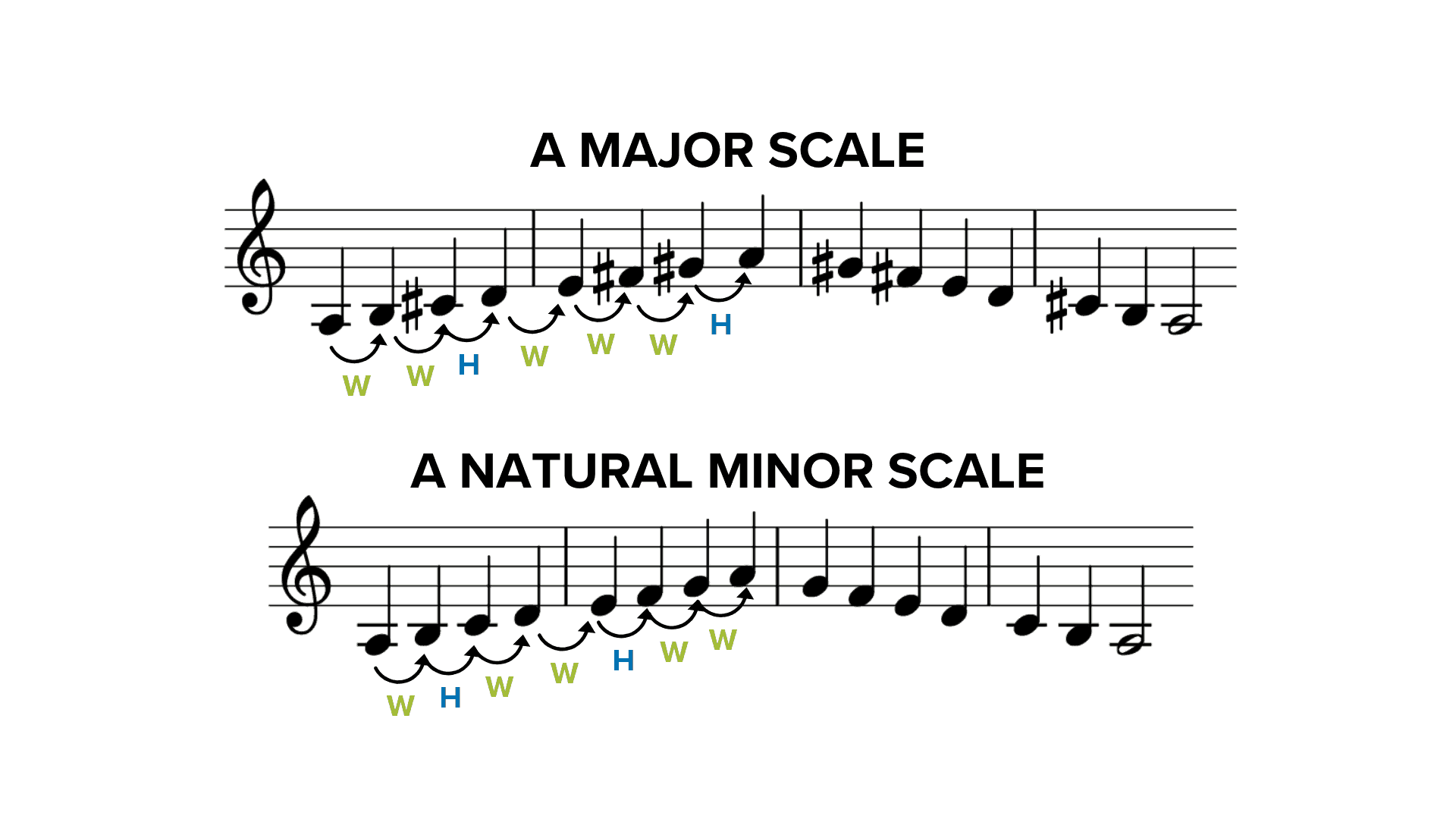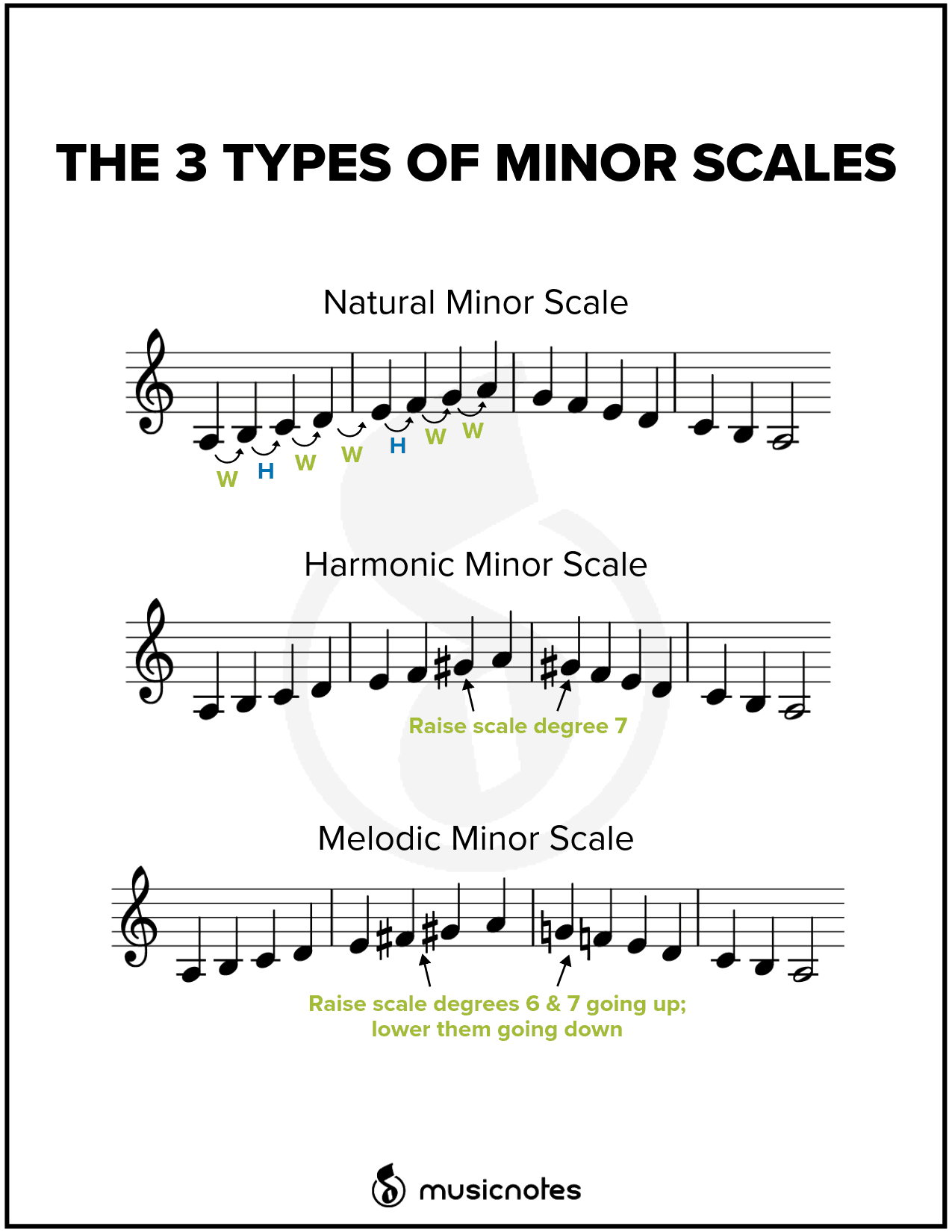The 3 Types of Minor Scales in Music
Learn more about the 3 types of minor scales in music: natural, harmonic, and melodic with tips on how to implement the minor scale into your sessions.

In music theory, the primary scales that musicians learn are diatonic scales.
Though you are probably more familiar with the terms “major” and “minor,” a diatonic scale is a scale with seven pitches. These pitches include five whole steps and two half steps.

In this article, we are going to focus on what is a minor scale in music. The above picture features a natural minor scale. There are three types of minor scales commonly found in music composition.
- Natural Minor Scale
- Harmonic Minor Scale
- Melodic Minor Scale
In the video below, we are going to give you a quick overview of each scale. Stick around afterward for further review and resources!
Let’s review the three types of minor scales.
The Natural Minor Scale
The natural minor scale is the naturally occurring diatonic scale with no altered scale degrees or added accidentals. Accidentals refer to sharps, which raise notes by a semitone, or flats, which lowers notes by a semitone.
This scale is also referred to as the Aeolian Mode or the 6th mode of the major scale.
To convert a major scale into a minor scale, lower major scale degrees 3, 6, and 7 by one half step to get the minor scale.
While minor scales are typically associated with dark moods or sad feelings in Western music, the natural minor scale may not always express these somber emotions. This type of minor scale can sound calmer and less mournful.

The Harmonic Minor Scale
The harmonic minor scale is nearly the same as the natural minor scale, but with a raised 7th scale degree. This scale expresses the expected minor sound more than the natural minor scale.
The harmonic minor scale is often seen in jazz compositions. Once you master this scale, musical improvisations can become easier.

The Melodic Minor Scale
The melodic minor scale is the most complex out of the three minor scales.
It raises scale degrees 6 and 7 from the natural minor scale when ascending but lowers them to their natural minor state when descending.
This minor scale is referred to as melodic because it is considered the easiest scale to sing. The unique quality of this scale is that it expresses both minor and major sounds. In the middle of the melodic minor scale, there are two sets of tritones, which lend an internal dissonance to its overall sound. A tritone refers to the interval of three whole tones within a scale.
Out of all the minor scale types, the melodic minor scale gives musicians the most artistic freedom. Musicians might not lower the scale degrees when descending if they enjoy the unique sound of the raised 6th and 7th scale degrees.

Tips on Mastering the Three Types of Minor Scales
Here are a few tips for familiarizing yourself with minor scales in music.
- Convert the natural major scale to get to the natural minor scale: Lower pitches 3, 6, and 7 by a half step to form the minor scale.
- Start with the natural minor scale to form the other minor scales: Raise the 7th pitch by a half step to get the harmonic minor. Raise the 6th and 7th pitch by a half step as you ascend and return to the natural minor scale as you descend to get the melodic minor scale.
- Practice, practice, practice: Playing the minor scales back-to-back will help you become more attuned to the different sounds of each scale. To become even better at identifying these scales, play the major and minor scales of a particular key in one set. Repeat these sets several times until the pattern becomes more apparent.
We wanted to give you a printable guide you can use while you’re memorizing these scales. Click here for the free PDF of the image below!

We hope you are now feeling a little more comfortable with the different minor scales. You can start incorporating them into your warm-up by playing or singing through each, going up a half-step, and repeating the process for an octave or two! Once you are familiar with the different types of minor scale sounds, you will see these scales popping up all over your sheet music and you will hear them in various songs.
For more great articles on music theory, click here! Happy learning!
FAQ
- What is the pattern for a minor scale? The pattern in the different types of minor scales can be seen by the whole steps or half steps between scale degrees.
- Natural minor: W, H, W, W, W, H, W, W
- Harmonic minor: W, H, W, W, H, W+, H, H
- Melodic minor: Ascending – W, H, W, W, W, W, H. Descending – W, W, H, W, W, H, W
- What is the minor scale formula? In all 3 minor scales, the third scale degree is lowered by a half step or semitone from the major scale. To convert to the minor scale, lower the 3rd, 6th, and 7th pitches of the major scale counterpart.
Related Products:

